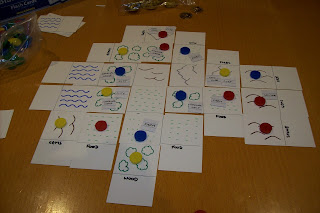So, the idea was more seasonal than would normally be expected for a grinch like myself: decorating Christmas trees, with the angel requirement being met by players being able to add an angel to the top of the tree to "complete" it and lock the scores in. The requirement of the contest is just something that has to be incorporated into the game in some (any) way, and not necessarily as a major part of the theme or setting.
 |
| Yellow is doing pretty well, despite no angels placed yet. |
The game, now it is mostly designed and functional, is essentially a very simple area control game. At any given point there are four trees that can be decorated, and access to these is restricted by rolling dice. At the end of the game, points are scored for being first or second place in terms of having the most decorations on each tree, and there are bonuses for anyone who manages to place an angel.
I've already started thinking of places to improve the game -- first among which is the way that the dice are handled and passed between players, as I definitely didn't nail this. But overall, I think I am reasonably content with how this one turned out, given the restriction.
Incidentally, something that has just occurred to me is that I seem to be becoming more willing to use dice in a game. I went for a long time wanting to avoid rolling dice, but maybe it is a result of my recent exploration of lightweight games that has shifted my perspective. Dice are just so widely accepted by "normal" people as a part of games that they can often be slotted in to smooth over aspects of a game that might otherwise need to get far more complicated. Many "hobby gamers" might push back against their use, but then the games I have been working on lately haven't been aimed at them, so it's fine really. Maybe I should think about this some more and figure out what is going on here.
If you are interested in this latest game, An Angel On Top, you can look at the files here...
An Angel On Top v0.1 rules on Dropbox
An Angel On Top v0.1 cards on Dropbox
And you can look at the December 24 Hour contest and see what other folk are doing too.


























